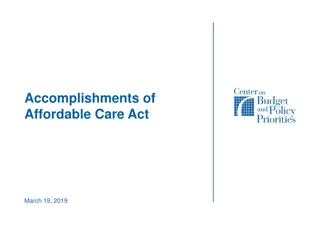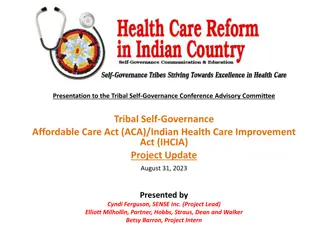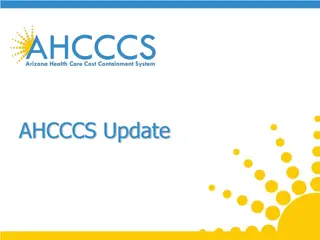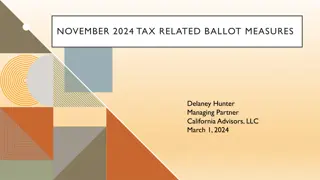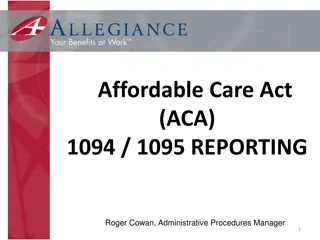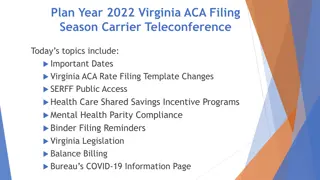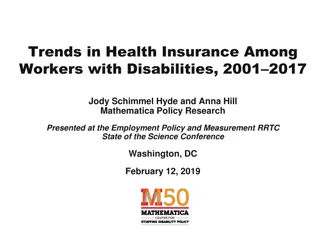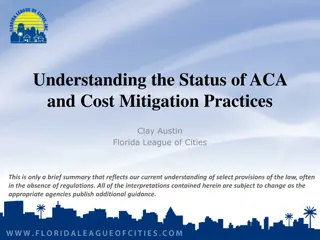
Affordable Care Act Measurement Periods
"Learn about how the Affordable Care Act (ACA) measurement periods work for employers, including initial measurement periods, stability periods, and administrative periods. See examples for new hires and ongoing employees to determine full-time status effectively."
Download Presentation

Please find below an Image/Link to download the presentation.
The content on the website is provided AS IS for your information and personal use only. It may not be sold, licensed, or shared on other websites without obtaining consent from the author. If you encounter any issues during the download, it is possible that the publisher has removed the file from their server.
You are allowed to download the files provided on this website for personal or commercial use, subject to the condition that they are used lawfully. All files are the property of their respective owners.
The content on the website is provided AS IS for your information and personal use only. It may not be sold, licensed, or shared on other websites without obtaining consent from the author.
E N D
Presentation Transcript
Affordable Care Act (ACA or Obamacare) Was signed into law in 2010 Requires employers of a certain size (USU is that size), who offers health insurance to their employees, to offer medical coverage to any employee who works over a 30 hour a week average Requires the employer offer medical coverage only to the eligible employees An employer has to be able to prove that they offered health insurance to no less than 95% of their eligible employee population or they may be subject to a penalty ($2500 per full- time employee minus the first 30 will be incurred)
Measurement Periods Initial Measurement Period Initial Stability Period Standard Measurement Period (SMP) Administrative Period Stability Period Crying Period Acceptance Period
Example: New Hire - Suzy Q. Hire Date October 10, 2019 Sample Look-Back Initial Measurement Period and Stability Period to Determine Full Time Status Admin Period Admin Period Initial Measurement Period Initial Stability Period Oct 10 - Oct 31, 2019 Nov 2020 November 1, 2019 - October 31, 2020 December 1, 2020 - November 30, 2021 Nov 2019 Dec 2019 Jan 2020 Feb 2020 Mar 2020 Apr 2020 May 2020 June 2020 July 2020 Aug 2020 Sept 2020 Oct 2020 Dec 2020 Jan 2021 Feb 2021 Mar 2021 Apr 2021 May 2021 June 2021 July 2021 Aug 2021 Sept 2021 Oct 2021 Nov 2021 1 May 2020 June 2020 July 2020 Aug 2020 Sept 2020 Oct 2020 Months Dec 2020 Jan 2021 Feb 2021 Mar 2021 Apr 2021 Overlaps ongoing measurement > *Initial Measurement Period and Administrative Period cannot be greater than 13 consecutive months plus fraction of a month
Newly Hired Employees will Become On Going Employees Sample Look-Back ongoing Standard Measurement Period and Stability Period to Determine Full Time Status Administrative Period May 1 - June 30, 2021 Standard Ongoing Measurement Period Stability Period* May 1, 2020 - April 30, 2021 July 1, 2021 - June 30, 2022 May 2020 June 2020 July 2020 Aug 2020 Sept 2020 Oct 2020 Nov 2020 Dec 2020 Jan 2021 Feb 2021 Mar 2021 Apr 2021 July 2021 Aug 2021 Sept 2021 Oct 2021 Nov 2021 Dec 2021 Jan 2022 Feb 2022 Mar 2022 Apr 2022 May 2022 Jun 2022 1 2 Still in the Standard Ongoing Measurement Period Ongoing Stability Period < End of Initial May 2020 June 2020 July 2020 Aug 2020 Sept 2020 Oct 2020 Initial Stability Period Overlapping Ongoing Months * Suzy is still covered from December 1, 2020 - November 30, 2021 based on Initial stability period. She is continued as covered from June 1, 2020 through December 31, 2020 only if she is determined to be full time during standard ongoing measurement period that ended October 1, 2019. Administration Period - employees that remain eligible are kept on plan but employees that do not maintain eligibility are taken off plan. Employees that regain eligibility during the ongoing Standard measurement period are added on the plan July 1st.
Who is exempt from ACA eligibility? Work Study Vista/Americorps Who is eligible for ACA coverage? P10 s Exempt working a 30 hour a week average (1560 hours per measurement period) P03 s - Grad Students reporting an average of 30 hours a week worked or more 20 hours credited per week (1560 hours per measurement period) P05 s - Wage Hourly employees working a 30 hour a week average 30+ hours a week (1560 hours per measurement period) P07 s Teaching No Benefits, working a 30 hour a week average 2.25 per credit + office hours (1560 hours per measurement period)
Rules of enrollment Coverage starts upon start date of the full-time hourly position Or Coverage starts after administrative period once an employee has been deemed eligible Rules of termination If upon the SMP the employee has not worked 1560 hours during that period If upon an employee experiencing a downshift in position and do not choose to continue coverage Coverage ends on the 15th or the last day of the month If moving from benefitted to non- benefitted and are qualified, if they do not average 130 hours per months for 3 months they lose coverage
Process for the departments Make sure the employees complete an ACA form upon hire, transfer to their department, change in employment status. Turn paperwork into HR timely Then Hayden enrolls the employee Hayden also sets up in PEAREVW for 1095 process (1095's are sent out to every employee in March) Departments should notify Hayden if they know the employee is terminated or no longer working full-time hours
OTHER ITEMS TO REVIEW: 26 WEEK QUALIFICATION -Break in employment must be over 26 weeks or it is not considered a break in employment and the employee get s credited for hours during the break. DOWNSHIFT RULE - If they worked enough hours to qualify with hours from their benefited position and currently have insurance, we would offer them ACA. If they do not average 130+ hours a month for three months they would lose coverage. OPEN ENROLLMENT PROCESS - Every year in May, if they are on ACA and qualify for insurance, they will be offered a chance to make changes. FUTURE OF ACA -No changes on the horizon







